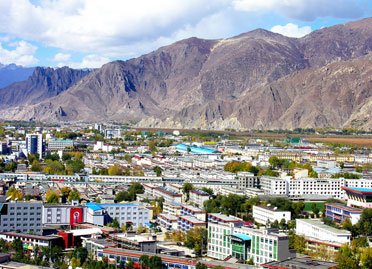Where am I : India Tour Packages » Most Popular Packages » Shigatse Tour Packages
Traveling to Shigatse
Shigatse has become an increasingly accessible tourist destination for travelers. But what is so special about this region that continues to attract onlookers and pilgrims from all over the world? Natural landscapes of surreal beauty, the spirituality of monasteries, Buddhism, and traditional culture ... are the keywords associated with Shigatse. Shigatse is the second-largest city in the Tibetan Region and the capital of Tsang Province. Shigatse is located west of Lhasa. Now it is a large modern city. At the foot of the hill, on which the fortress of Shigatse Dzong is located, a small Tibetan old city is nestled, where old Tibetan buildings and structures have been preserved. Shigatse has long been an important commercial and administrative center. The fortress was once home to the kings of Tsang. The city does not lose its significance even now because it is located on the main highway leading from Lhasa to the west. Since ancient times, Shigatse, or the nearby Tashilhunpo Monastery, has been the residence of the Panchen Lamas, manifestations of Buddha Amitabha, second in rank in the Gelug School after the Dalai Lamas. To make the most of what it offers, we suggest the top places to visit when traveling to Shigatse.
Bit of Shigatse tour
Tibet is has a large and snowy land. This is certainly a great attraction for adventurers. Apart from that, its rich culture, fascinating Tibetan Buddhism, and of course, the unique natural landscapes offer travelers an extraordinary experience. Shigatsé is known to have once been the residence of the Panchen Lama. The majestic palaces, monasteries, and other buildings that once symbolized the political power of Shigatse have now become exceptional sites attracting more and more tourists every year. This is why Shigatse is still one of the most important cities in Tibet. In addition to these relics of the past, the city is placed on a high plateau where the beauty of the scenery is extravagant. Mount Everest dominates these big chains of snow-capped mountains. To the northwest of the city, you will find Tashihumpo Monastery, considered by many to be the most beautiful place in Shigatse. Its golden roofs and red walls give it this atmosphere that is both mysterious and imperial. It houses one of the largest copper Buddha statues. The Palace of the Panchen Lama is located southeast of the city. There are magnificent pieces of Tibetan art and several sacred objects. Strolling through the streets will allow you to discover traditional Tibetan dwellings. The walls of the houses are all white, but beautiful paintings are supposed to drive out the devil. You can reach Shigatse quite easily from Lhasa. Shuttles provide the daily trip, and it is even possible to rent cars. If you fly directly to Shigatse, be aware that the airport is 43 kilometers from the center. Note that the city is not very big and you can quickly get around on foot or by rickshaw. If you want to leave the city, you must rent a car with a driver. This is more easily found in Lhasa than in Shigatse. From April to November, the temperatures are most often in the negative. In the middle of winter, they can even drop to -25°C. June and July are two stormy months. It is therefore advisable to visit Shigatse between April and June. Because of the altitude, the climate is very harsh. It is necessary to plan to protect oneself from the sun's damaging rays and have something to warm up, especially at night.
Attractions of Shigatse
The best places to visit in Shigatse include Mount Everest, Sakya Monastery, Tashilhunpo Monastery, etc. In some way, they represent a particular character or role Shigatse showed to the world.
Fortress Shigatse Dzong
At the entrances to Shigatse, travelers first see the Shigatse Dzong fortress, which looks like the Potala Palace. The fortress is also called the "Little Potala" for its similarity with the palace of the Dalai Lama. It was initially built in the 17th century. Once Shigatse Dzong was the residence of kings and then the rulers of Tsang, and it was around it that the city of Shigatse grew. Unfortunately, little remains of the original fortress today. In 1959, it was severely damaged and only in 2005-2007 was it restored anew. This majestic building again amazes travelers approaching the city with its appearance, although after the reconstruction, the fortress became somewhat smaller in size. Excellent views of the fortress also open up from the kora around the Tashilhunpo monastery, which is not far from it.
Fabulous views of the monastery and fortress.
For most tourists, there are only two main places to visit in Shigatse - the monastery of Tashilhunpo Panchen Lama and the old fortress, which looks like a miniature of the Potala in Lhasa. But the most exciting thing is the ascent to the observation ridge above the city, from where a beautiful view of the whole city opens. Without dispute, this tour is the best activity you can do in the second largest Tibetan city.
Entrance to Tashilhunpo Monastery.
For most tourists, the tour of Shigatse begins at the entrance to Tashilhunpo Monastery. This is also the start of this tour. You can see the first goal - a chorten on a ridge high above the monastery.
Panchen Lam Summer Palace
The palace complex was built in 1844 by the seventh Panchen Lama and is an odd mixture of a traditional Buddhist temple and a Victorian estate. The palace's interior is richly decorated with frescoes. Especially noteworthy is the fresco depicting a Buddhist hell, frightening with its details. On the second floor are the rooms of the Tenth Panchen Lama, one of which has his office with a desk and telephones. There is also an audience hall. There is a throne in each room to which pilgrims must bow to.
Climbing the ridge
The climb is pretty intuitive, as there is no direct path to the ridge from this side. However, climbing is not that difficult, only sometimes you need help with your hands. As the altitude increases, a beautiful view of Shigatse and the wide Yarlung Tsangpo valley opens up.
The atmosphere on the ridge
The atmosphere on the ridge, at an altitude of about 4150 m above sea level, is indescribable. There is no one outside of you, thousands of flags, and beautiful views from all sides.
Palkhor Monastery
Palkhor Monastery, located 100 km east of Shigatse, is a monastery that combines Han, Tibetan, and Nepalese architectural features. As it houses three sects: Sakyapa, Kadampa, and Gelugpa at the same time, it enjoys a high status in the history of Tibetan Buddhism. Referring to the Tibetan calendar, Saka Dawa Festival is celebrated on April 15 to commemorate Sakyamuni, the founder of Buddhism. During the festival, there will be about 500 Lamas chanting sutras and loyal pilgrims gathering at the monastery. It houses about a hundred thousand images of various icons.
Carola Glacier
One of the four snow-capped mountains in Tibet is Jingangsang. Like a beauty quietly dressing up, Carola watched from afar in the middle of the mountains. It is reported that the Karola Glacier is the closest to the highway in the whole of Tibet, which is only about 300 meters away from the highway. After crossing the Smila Pass, it came to the ice tongue of the Carola Glacier. The front of the ice tongue is about 5,560 meters above sea level, and the place to watch the Karola Glacier is about 5,400 meters above sea level. The area about 5,600 meters north of the mountain pass belongs to the hanging glacier formed after the Ningjin Kangshafeng Glacier drifted southward. It is the prominent peak of Laguigangri Mountain, north of the Himalayas. More than ten peaks over 6,000 meters high around Naijingangsang, one of Tibet's four central snow-capped mountains.
Mount Everest
Mount Everest is also called Mount Qomolangma, which means "goddess" in the Tibetan language. Mt. Everest rises south of Tingri County in southern Tibet, on the border of the Central Himalayas between China and Nepal, covered in accumulated eternal snow. Its snow top sends out a silvery sheen year after year. Its size is hidden in the clouds. The optimal weather to visit Mt. Everest is from April to June, a golden period for climbers. Every year, many challenging and brave mountaineers come from all over the world to visit and climb Mt. Everest, hoping to fulfill a lifelong dream of climbing the highest peak in the world and seeing it. Climbers need to know that many hazards can affect them. At the top, the oxygen level is so low that it is thought to be only 1 to 3 of the level near the sea. The wind is also mighty, hitting almost 118 miles per hour. This powerful wind is locally called the "Jet Stream," and many times, it is the one that does not allow climbers to reach the summit. Mount Everest is south of Tingri County on the central Himalayan border between China and Nepal, covered with eternal snow. Its snow peak reflects silver radiation from the suar with its waist hidden in the clouds. It is a golden period for mountaineers as it does not rain or snow much. Every year, many brave mountaineers come from around the world to explore the highest mountain and fulfill their lifelong dream.
Sakya Monastery
Sakya Monastery is located 160 km west of Shigatse. It is the main monastery of the Sakyapa sect of Tibetan Buddhism. The medieval architecture of Mongolia is very different from the temples of Lhasa and Yarlung. Sakya Monastery is the Second Dunhuang due to its colossal collection of numerous Tibetan Buddhist scriptures, murals, and Thangkas. The main halls within the monastery are the Dajing Hall, the Buddhism Hall, and the Sakya Archbishop's Hall, built in the style of Yuan architecture.
Shalu Monastery
The monastery of the Sakya School, built in the 11th century, is located 40 kilometers from Shigatse. The monastery is famous for its frescoes in the Pala technique. In the 13th-14th centuries, the famous Budon Rinchendub, a historiographer, translator, and author of the classic work "The History of Buddhism in India and Tibet," is studied in Tibet to this day here.
Kora around Tashilhunpo Monastery
We decided to make this description separately because, along the course of the kora, you can enjoy beautiful views of the city and the monastery. The bark takes about an hour. After leaving the monastery gate, go clockwise and continue to a small street to the right. This street will take you along the western wall of the monastery, where you will see makers, stone carvers, and monks reading Buddhist scriptures. Then you must climb up the hills above the monastery, hung with prayer flags. From here, you will have a great view of the Tashilhunpo monastery. After a while, you will pass a massive wall on which a giant thangka is hung during the festival. Then the trail splits in two: you can go down the hill and complete the kora,
Zhangmu City
Unlike other dry and cold regions of Tibet, Zhangmu is mild and humid due to its subtropical climate. As a port, Zhangmu is always crowded with flesh-colored tourists and people in business.
Booming border trade attracts traders from inland China, Tibet, and Nepal who do business in Zhangmu City. Nepalese merchants export rice, flour, pepper, vegetables, and perfumes, while Chinese merchants sell wool, tea, salt, and Tibetan medicines. The Nepalese even run Nepalese restaurants in the small town, serving Nepali dishes, instant noodles, and beer produced in Nepal.
Information for a trip to Tibet:
The initial eight days became seven due to the cancellation of the Kathmandu-Lhasa flight due to bad weather. Fortunately, we could recover everything that was planned except, unfortunately, the overnight stay at Everest Base Camp, but so be it.
Flights: Kathmandu-Lhasa one-way ticket with Sichuan Airlines booked at the end of January for the end of April.
Hotel: as I already told you in the post on how to organize a trip to Nepal and Tibet, it is not possible to visit Tibet independently.
This means relying on a local agency to take care of everything, including hotel reservations. We slept in mid-range hotels: breakfast was included for all of us, and we were okay. Only in the Xegar hotel did we suffer a bit from the cold.
Visas and permits: to enter Tibet from Nepal, you will need to stay on Nepalese soil for at least three working days, which is the time your agency needs to complete the procedures for obtaining a Chinese visa. In addition to the visa, the agency will provide you with the Travel Tibet Bureau Permit, a document that you will receive in two original copies to be presented upon entering and leaving Tibet, as well as the Public Security Bureau Permit, which will serve you to pass the various checkpoints on the road from Lhasa to the border with Nepal.
Means used: in the package with our agency, all the trips with the minibus that accompanied us from Lhasa to the border with Nepal along the so-called Friendship Highway, including petrol supplies.
Altitude: the average altitude of the Tibetan plateau is 4,000 meters, going from 3,600 meters in the capital Lhasa to 5,200 meters at Everest Base Camp.
The ability to acclimate more or less quickly does not depend on physical form or training, so some precautions can still be taken. The first is drinking as much as possible, making an effort even when you are not thirsty. You can then help yourself by taking the infamous Diamox, a diuretic that lowers blood pressure.
Finally, an excellent trick is always staying overnight at a lower altitude than the maximum one reached during the day.
Where to stay in Shigatse?
Staying in a good hotel is one of the beginnings of a successful holiday. Indeed, a reasonable accommodation can make your vacation even more exceptional… just as a bad one can ruin a stay. A critical point of passage to Everest's base camp, Shigatsé, is full of places to stay. You will find something for all budgets, from small bed and breakfasts with incomparable charm to large luxury hotels located in the city center, near the main sites to visit, or in the surrounding countryside. This is why we have selected the best hotels in Shigatsé for you, combining comfort and quality of service.
Where to eat in Shigatse?
If you come to Shigatse, I recommend going to Shigatse Word Kitchen for dinner. It is a beautiful place, and the food is delicious and reasonably priced. At night they had music shows and traditional dances, a recommended place.
After knowing Shigatse, we continue our trip. The following day we headed to Sakya, a fortified monastery utterly different from the rest of the monasteries in Tibet, but that's another story.
Bottom line
Shigatse is one of Tibet's most attractive tourist destinations, with ancient cultures and magnificent natural landscapes. This article on traveling to Shigatse has organized and introduced detailed strategies for various tourist attractions in Shigatse, hoping to help you. The best places to visit Shigatse are famous and popular attractions for domestic and foreign tourists. Now come and explore this fantastic city.
Speak to our Experts!
Instant Quote, Best Deals - 100% Customizable, Includes hotels + car + guides Cost depends on various factors like, number of people you are, travel dates, category of hotel and transportation etc.Drop your Inquiry to get the best deals as per your requirements. 100% Satisfaction Guaranteed. Rated 5* in TripAdvisor.Loading...





